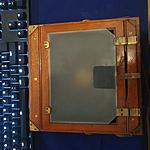
Originally Posted by
Doremus Scudder

Despite what Tin Can says, it seems illogical to me that a camera design would intentionally place the ground side, i.e., the viewing/image forming surface, of the ground glass away from the lens. That would mean light from the lens would have to pass through the clear part of the glass before forming an image, which would result in a focus shift caused by the glass thickness. Yes, that could be designed in, but it's so much easier and intuitive to just have the ground glass facing the lens that I imagine that's what was standard practice both then and now.
So, IF your camera is designed to have the frosted surface of the ground glass facing the lens, then replacing the original ground glass with a thicker one should make no difference as long as the plane of the frosted surface is in the same position as the original.
If, on the other hand, I'm wrong and your camera really was designed with the frosted side of the ground glass facing the photographer, then you need ground glass of exactly the same thickness (and refractive index!) to avoid a focus shift. Still, I doubt that this is the case.
Knowing the original configuration of your camera would certainly help...
Best,
Doremus




 Reply With Quote
Reply With Quote




Bookmarks